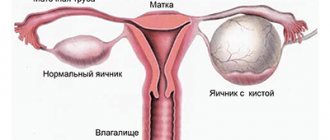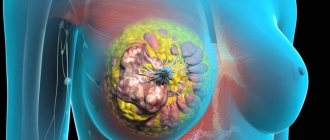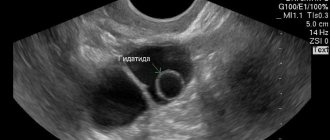Primary appointment/consultation with a gynecologist—RUB 1,700. Repeated appointment/consultation with a gynecologist—RUB 1,200. See all prices
+7 (499) 400-47-33
Bartholinitis (Bartholin gland abscess, Bartholin gland cyst) is a disease in which the Bartholin glands become inflamed. These glands are located on both sides of the vagina in the area of the labia minora (in the vestibule of the vagina). Their main function is to maintain moisture at the vaginal opening during sexual intercourse. The excretory ducts of the glands open onto the surface of the labia minora. When the ducts are infected (with sexually transmitted infections - gonorrhea, trichomoniasis and chlamydia, less often - gonococci, streptococci, staphylococci, E. coli and other microorganisms), inflammation occurs, which can subsequently spread to the entire gland and surrounding tissues. In most cases, only one gland becomes inflamed, i.e. the inflammatory process is one-sided.
The reasons for the development of bartholinitis are infection through the excretory ducts of the Bartholin glands. This is facilitated by:
- Insufficient genital hygiene;
- Unprotected sexual intercourse;
- Sexual intercourse during menstruation;
- The presence of diseases such as colpitis, urethritis, the presence of sexually transmitted diseases;
- Decreased immunity.
General information about the disease
Pathology is formed due to advanced infection or blockage of the Bartholin gland duct. Often the disease occurs against the background of bartholinitis
, purulent inflammation of bacterial etiology.
In essence, a cyst is a small swelling in the labia area, containing in its cavity the mucous secretion of the gland. The dimensions of the compaction are not static and vary from 1 to 8 cm
, depending on the severity of the pathology. The average age of patients is 20-30 years, the most sexually active period of a woman.
It is not easy to detect a cyst
. With a small volume, it has no pronounced signs and remains invisible for a long time. The situation becomes clear in later forms, when the pathology begins to cause the woman significant physiological discomfort and a number of painful sensations.
The standard and effective treatment for Bartholin gland cysts is surgical removal of the inflamed bladder. But for certain indications, an alternative way to solve this problem is also allowed.
About treatment with folk remedies
It often happens that cysts occur in women with weakened immune systems. In these and other cases, treatment with folk remedies can help. Before doing this, you should consult your doctor, because some medications can cause great harm. To strengthen the immune system, you need to prepare a mixture. To do this, take 150 g of nut (it is better to grind it using a blender) and add 0.5 liters of honey. After mixing the ingredients, add 1 tsp. dill seeds and 50 g of garlic (boil it so that the pungent smell disappears). All this is mixed and taken in small quantities before meals. Regular use of the mixture improves immunity and does not give a chance to develop a cyst. For internal use, prepare a mixture of 20 aloe vera leaves, 0.5 kg of honey and 0.5 liters of wine (like Cahors). Next, the components are thoroughly mixed and boiled in a water bath for 1 hour. To prevent the medicine from spoiling, it must be stored in the refrigerator. Take in small quantities before meals.
Causes of development of Bartholin gland cyst
Factors affecting the introductory duct may include:
- sexually transmitted diseases - trichomoniasis, ureaplasmosis, mycoplasmosis, gonorrhea;
- low general and local immunity;
- pathogenic microflora - staphylococcus, E. coli, streptococcus;
- chronic infection;
- failure to maintain intimate hygiene;
- mechanical trauma to the skin due to depilation;
- abortion, gynecological procedures and other interventions;
- rare sexual intercourse with microtraumas;
- thrush;
- tight and synthetic underwear.
Any of the reasons is a favorable environment for the development of cysts. In addition, it may be accompanied by other diseases, which cannot be cured at home.
Honey, dill seeds, garlic and nuts
Now you even know a recipe for mulled wine, which you can use to get rid of a tumor near the vagina. However, if you don’t like products that need to be used externally, then we recommend that you familiarize yourself with this unusual tincture that is used internally. It will not only get rid of the pathology itself, but will also increase the body’s immunity. Here is a list of ingredients you will need:
- 0.3 kilograms of walnuts;
- 0.1 kilograms of garlic;
- 50 grams of dill seeds;
- 1 kilogram of honey.
All components are thoroughly mixed together, and then sent to the fire for heating. Boil the folk remedy for 5 minutes, then cool it. You should take the “treat” at 120 milliliters per day. It is best to stretch this portion 4 times so that the body has time to absorb beneficial microelements. The maximum duration of therapy is 1 month, but usually the symptoms begin to subside much earlier.
Signs of the disease
The clinical manifestations of Bartholin gland cysts are quite specific. The uncomplicated form is detected only during an oncological examination in the gynecologist's office. In other cases it is noted:
- discomfort in the perineal area during walking, sexual intercourse, sitting and wearing tight-fitting clothes;
- periodic pain in the labia majora and their swelling;
- poor general health;
- the formation of a clearly palpable compaction in the thickness of the labia;
- temperature rise to 38-39°C;
- chills, weakness and headache;
- redness of the skin in the tubercle area.
Sometimes the bubble can spontaneously open, releasing a purulent infiltrate.
The severity of symptoms is directly related to the nature of the inflammatory processes occurring in the cyst and the stage of its growth.
Operation
If the cyst reaches a small size (1-2 cm), then there is no point in surgical intervention. Such formations can resolve on their own over time, by normalizing the shade of the secretion. These types of cysts may be removed for cosmetic purposes or to prevent recurrence.
If the size of the cyst is much larger, there is discomfort in the genital area, and sharp pain is felt during sexual intercourse, then the outflow of fluid can only be restored through surgery.
To remove a cyst, the following methods are used:
- Drainage of the cyst. For this procedure, a special tube is used, through which the stagnant secretion drains out. The effectiveness of the method is quite low, as relapses occur. Sometimes, after several repeated formations, the stork itself has to be removed.
- Marsupialization of the cyst. A surgical procedure that involves the creation of an artificial excretory duct, which will be formed over the course of two months. In this case, the gland is preserved, although in case of relapse it will be subject to extirpation.
- Placement of a word catheter. A small incision is made on the formation, after which the stagnant secretion is removed, and a silicone tube with a balloon at the end is installed at the wound site. You need to walk with this installation for several weeks, due to which a new duct is formed.
- Puncture of Bartholin gland cyst. A puncture is made on the cyst with a needle and the contents are sucked out. This method is most often used to treat pregnant women or in cases where surgery is temporarily impossible.
If the Bartholin gland cyst begins to fester, then first of all the pus is removed, and then a new protocol is formed. In the postoperative period, women are prescribed physical therapy and medications with an immunostimulating effect.
Indications
A specialist should prescribe surgery if:
- The abscess is acute or recurrent.
- A cyst has formed in the Bartholin gland.
- The process of suppuration began in the gland duct.
- The fistula tract does not heal after self-opening of the abscess.
results
After opening the abscess, women feel better, their temperature drops and other symptoms are eliminated. Bartholinitis of the acute stage can be cured forever, although in some cases it becomes chronic. In the latter case, you need to carefully monitor your health, avoid overcooling, and follow the rules of personal hygiene.
If the abscess ruptures on its own, you still need to contact a surgeon. Sometimes a chronic small cyst forms, which does not cause any discomfort. But over time, it can increase in size and cause a lot of inconvenience.
Complications
A Bartholin gland cyst can have very unpleasant consequences. The main risk if the tumor is left untreated is the high probability of relapse and the development of an abscess.
. In addition, inflammation can become chronic, which is quite difficult to combat. Taking action in a timely manner will help avoid many complications and serious health consequences.
Cyst during pregnancy
The risks are especially high during pregnancy
, since the disease can pose a direct danger to the fetus. Everything will depend on the nature of the pathogens and the duration of pregnancy.
So, at an early stage of bearing a child, the probability of miscarriage is very high. The development of inflammation in later weeks is fraught with infection of the fetus and premature birth.
You can avoid such troubles by detecting the problem in time and carrying out the necessary therapy for the Bartholin gland cyst. Treatment without surgery in this case involves the use of antibiotics and homeopathy that are acceptable during pregnancy.
. Adequate therapy can minimize possible negative consequences and risks from the tumor.
Diagnosis and treatment of cysts
The key to effective treatment of duct inflammation is making the correct diagnosis. In the case of a Bartholin gland cyst, the clinical examination is a standard gynecological examination of the patient with the collection of biological material from her vagina for microscopy and culture for microbial composition, as well as sexually transmitted infections. The course of therapy is established only after receiving the results of the study.
Treatment of Bartholin gland cysts is carried out in several stages:
- Local physiatry
. The seal is treated with a special anti-inflammatory ointment - Vishnevsky, Levomikol - and antiseptic solutions for douching - Chlorhexidine, Miramistin, Chlorophyllipt. - Physiotherapy
. It is prescribed only when the patient’s condition has been stabilized and the signs of intoxication accompanying the cyst have been eliminated. Magnetic therapy, infrared laser, therapeutic mud, UHF, warming with paraffin or ozokerite are used. - Antibiotic therapy
. Broad-spectrum drugs are used to eliminate direct inflammation of the Bartholin gland and accompanying infections of the genital organs. Such medications include drugs with desensitizing, sedative, analgesic and immunomodulatory effects.
The standard duration of treatment is from 7 to 10 days. If therapy does not bring the expected results and the tumor progresses, they resort to surgical removal.
Antibiotic therapy for cysts
Proper treatment of such a disease is the basis of recovery. Most women are interested in whether antibiotic treatment can bring results. This result is possible if the patient does not self-medicate, then improvement occurs fairly quickly. Most often, antibacterial drugs belonging to the group of cephalosporins are prescribed for this disease. They are active against most pathogenic microorganisms. The course of treatment usually does not exceed a week. The dosage of medications is strictly individual. You should not stop it yourself or change the duration of use. This is the only way to cure a cyst without complications. Ceftriaxone (Cefuroxime, Cefotaxime, Cefuroxime, Cefoperazone) is the most popular. A doctor can prescribe it even during pregnancy (only if there are compelling indications for this). This antibiotic is available in the form of a powder from which a solution is prepared. The main contraindication for such drugs is their individual intolerance. And if you have to treat a cyst during pregnancy, then therapy is carried out only under the supervision of a doctor. Drugs of the cephalosporin group can be prescribed not only in the form of injections, but also tablets - these are Cefixime, Cefaclor, Ceftibuten. The dosage of oral medications is strictly individual. Fluoroquinols can be used if there is an individual intolerance to cephalosporins. Among these drugs, the most effective are Levofloxacin, Ofloxacin, Gatifloxacin. All such medications are prescribed only orally. They suppress the activity of most pathogenic microorganisms well, because they have a detrimental effect on their cells. The duration of treatment is determined only individually. Finally, antifungal drugs are also becoming widespread. These are Clotrimazole, Miconazole, Bifonazole, Ketoconazole. Used only as prescribed by a doctor.
What you need to know about antibiotic treatment?
If the patient carefully follows all the doctor’s recommendations regarding treatment, then the symptoms of the acute stage of the cyst will quickly go away. Here are some recommendations that any doctor gives when prescribing such potent drugs:
- During treatment you must stop drinking alcohol. It not only suppresses the activity of drugs, but also affects internal organs (liver, kidneys) and changes the composition of the blood. After completion of therapy, you must abstain from drinking alcoholic beverages for another 2 days.
- When diluting cephalosporins, you must carefully follow the instructions.
- Oral antibiotics should be taken with plenty of water. Do not chew the medicine.
- It is advisable to take medications after meals (unless otherwise indicated in the instructions or doctor's recommendations).
- During antibiotic therapy, the treatment regimen must be strictly observed. It is important to take the tablets at the same time every day. If it happens that the patient forgot to take the medicine, then there is no need to administer it when there is little time left before the next dose: in this case, the dose will increase sharply, and this is undesirable.
- If you do not use the medicine at the prescribed time, the disease will develop into a chronic stage and surgery may be required. This applies to all medications without exception.











